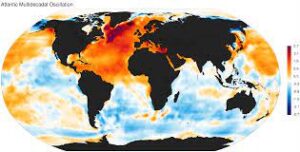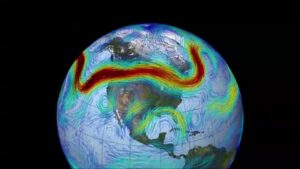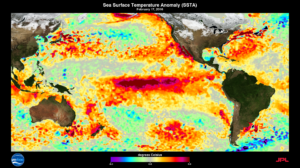Human influence on climate variability



Image 1: Key features of global climate variability. (Left) Sea surface temperature pattern associated with Atlantic Multidecadal Variability; (middle) the jet stream; (right) sea surface temperature pattern associated with El Nino.
1. Motivation
This exciting PhD project tackles an important, cutting-edge topic in climate change research. It is widely recognised that observed climate change signals are modulated by internal climate variability. Internal variability is an innate property of the climate, arising from complex, nonlinear interactions between different earth system components (e.g. the atmosphere and ocean) and manifests across timescales of a few years to millennia. It has been proposed that man-made climate change has altered the nature of internal climate variability, including the El Nino Southern Oscillation (Cai et al., 2021), Atlantic Multidecadal Variability and Pacific Decadal Variability (Smith et al., 2016). However, there are many open questions regarding the mechanisms for such connections and whether human influence on climate variability is already being observed. Major advances are needed to pin down the interactions between human caused climate change and internal climate variability to support the production of informative projections of future climate change.
2. Aims and objectives
The overarching goal of this PhD project is to isolate and quantify the effects of external climate forcing on internal climate variability. The student will achieve this by exploiting a new, unique dataset comprising thousands of state-of-the-art climate model simulations and applying advanced data science methods to identify signals.
Specifically, you will seek to answer the following research questions:
- What are the fingerprints of human influence (e.g. due to greenhouse gases, aerosols, land use change) on modes of internal climate variability?
- Are there fingerprints of human influence on internal climate variability that could be detected in observations?
- How will internal variability change under future climate change and which forcings are key to these changes? How do these changes affect future projections over the coming decades?
3. Methods
The project will exploit the brand new Large Ensemble Single Forcing Model Intercomparison Project dataset (LESFMIP; Smith et al., 2022). This provides thousands of simulations from climate models that isolate the effect of specific external forcings. Large initial condition ensembles are performed, where small differences in the starting conditions create different manifestations of internal variability (i.e. the “butterfly effect”). This is ideal for examining internal variability because it provides detailed sampling of the rich climate phase space. You will use machine learning to identify altered patterns of climate variability associated with different external forcings. You will use signal processing methods to ascertain when the signals of augmented internal variability will be detectible in observations. You will work alongside a co-supervisor at the UK Met Office and have the opportunity to visit and engage with researchers in the Monthly-to-Decadal Prediction Group.
4. Key outputs and potential for high impact
The influence of human activity on internal climate variability was highlighted as a key knowledge gap in the Intergovernmental Panel on Climate Change Sixth Assessment Report (IPCC AR6 2021). The availability of the unprecedented LESFMIP dataset now enables this gap to be addressed at a level of detail that has simply not been possible until now. This will be the most comprehensive attempt yet to understand the myriad drivers of climate variability and therefore has high potential to produce novel results. Your work will feed into the World Climate Research Programme’s new Lighthouse Activity on Explaining and Predicting Earth System Change (https://www.wcrp-climate.org/epesc), which is comprised of an international network of scientists working on climate prediction and projection.
5. Training and environment
You will be trained by experts in the active and supportive Physical Climate Change and Climate Dynamics groups within the Institute for Climate and Atmospheric Science at the University of Leeds. The institute comprises around 140 researchers covering all major areas of climate science. You will have the opportunity to undertake regular visits to the Met Office. You will benefit from an excellent wider research environment that includes technical support through the Centre for Environmental Modelling and Computing, access to Met Office models and data through the Leeds-Met Office Academic Partnership, and the Priestley International Centre for Climate, which promotes interdisciplinary climate research in Leeds. You will be part of the PANORAMA Doctoral Training Partnership, which fosters a lively community, and have access to bespoke training courses. You will have numerous opportunities to present your research at national and international conferences and meetings (e.g., EGU, AGU assemblies), as well as to attend summer schools and other training workshops.
The project would suite a student with a good first degree, Masters degree or equivalent in a physical or mathematical discipline (e.g., Physics, Geophysics, Mathematics, Meteorology, Climate Science etc.).
References
Cai, W., Santoso, A., Collins, M. et al. Changing El Niño–Southern Oscillation in a warming climate. Nat Rev Earth Environ 2, 628–644 (2021). https://doi.org/10.1038/s43017-021-00199-z
Smith, D. et al., Attribution of multi-annual to decadal changes in the climate system: The Large Ensemble Single Forcing Model Intercomparison Project (LESFMIP), Frontiers in Climate (2022) https://www.frontiersin.org/articles/10.3389/fclim.2022.955414/full
Wang, B., Sun, W., Jin, C. et al. Understanding the recent increase in multiyear La Niñas. Nat. Clim. Chang. (2023).https://doi.org/10.1038/s41558-023-01801-6
Smith, D., Booth, B., Dunstone, N. et al. Role of volcanic and anthropogenic aerosols in the recent global surface warming slowdown. Nature Clim Change 6, 936–940 (2016). https://doi.org/10.1038/nclimate3058
